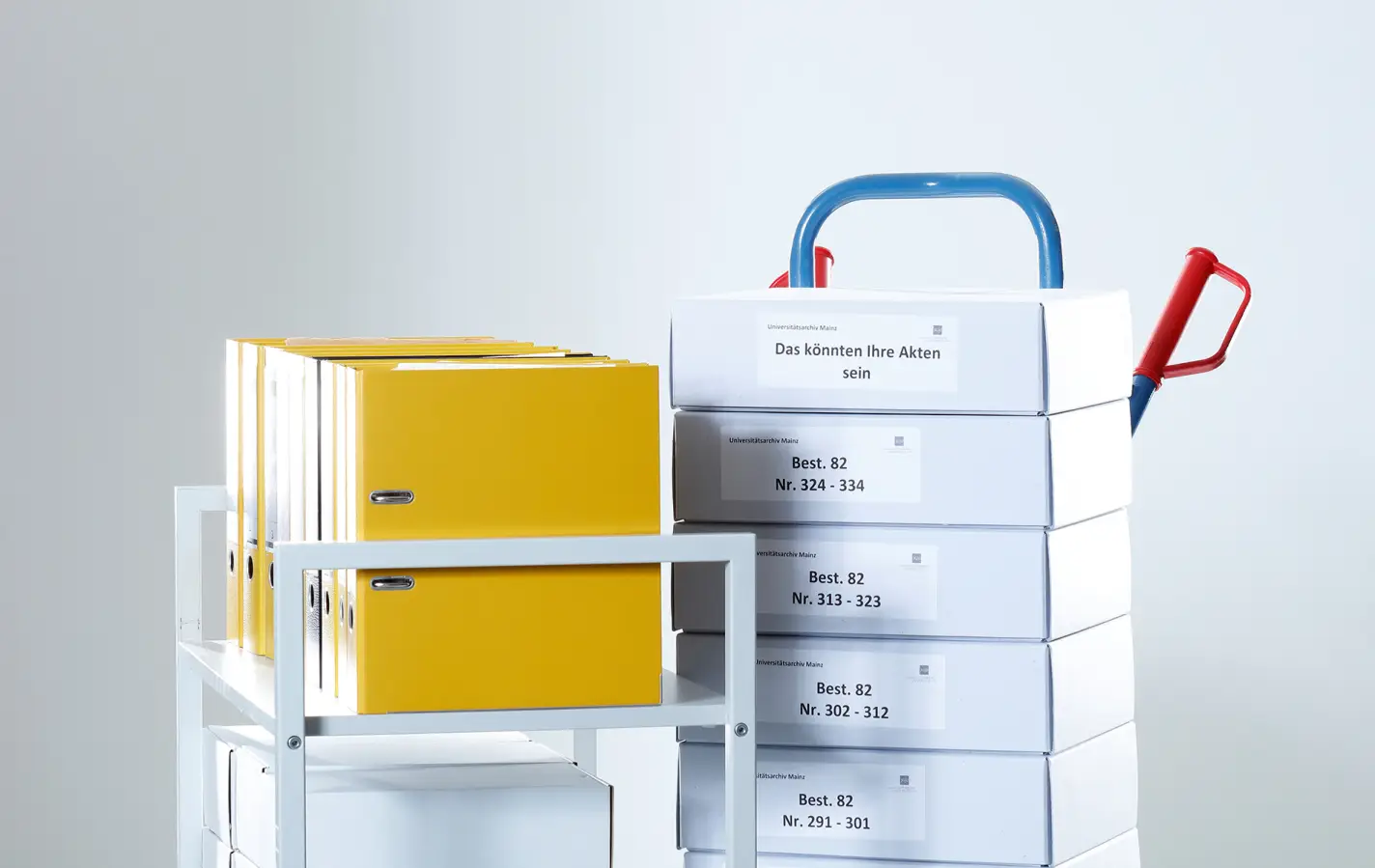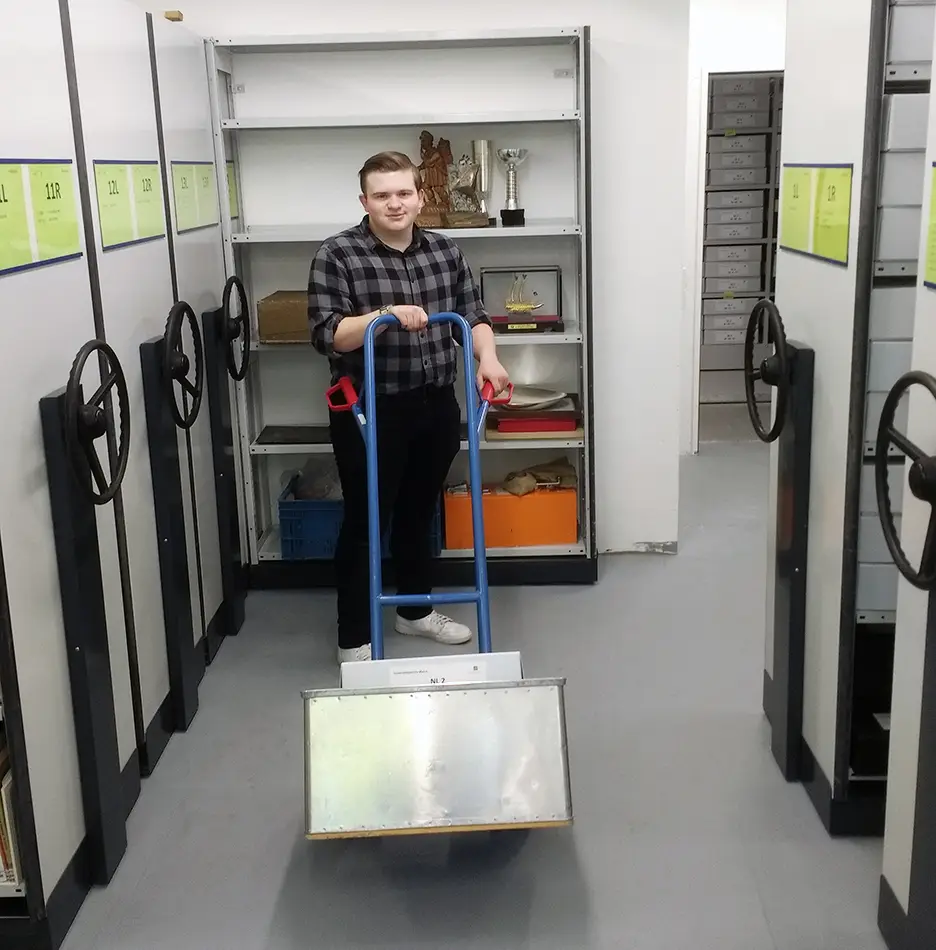Who doesn't know the graduation ceremonies from American films? With the students dressed in the stereotypical robes and graduation caps with tassels? Admittedly, this does not fit our vision of academic graduation ceremonies today. But who would have thought that such attire was once a custom at German universities? At that time, however, it was not students who wore these robes when they graduated, but rather professors. In the archive of our university, not only files are stored in cardboard boxes, but also robes and berets in the best Hollywood design. So the robes are there. But what about the proverbial “Muff von 1.000 Jahren”? This much can be said: Clothes are by no means all you might come across...
On His Magnificence and Spectabilities
Of course, at the start of my internship in the University Archives at the beginning of September 2019, I didn't know that either. As the semesters progressed – I was about to start my fourth in history and archaeology – I began to wonder where my journey should take me professionally. It was finally time for an internship. I wanted to break out of the rigid routine of lectures – term papers – and take a look into the "real" world of work. I had always been interested in archiving. On the website of the Department of History, I came across an advertisement from the University Archives, applied and received an offer a little later. After a preliminary discussion with archive director Christian George, I thought I had a reasonable idea of what to expect. Nevertheless, there were quite a few surprises.
During the tour to the various storage rooms of the archive on campus – the archivist calls them "closed stacks" – on my first day I immersed myself in the history of our university. When the departments were called "faculties", the "Old ReWi" was still new and the ZDV, if at all, was known as a "computer center". At that time, there were no university presidents, but rectors. They were reverently addressed with "magnificence", the deans with "spectabilis" and they occasionally dressed themselves in the flowing festive robes described above, and hammered letters out on typewriters. University was a bit different in the 1950s and 60s than you know it today, my supervisor Frank Hüther explained to me.
While we’re at it, let’s learn some archival technical vocabulary:
Ex•ca•vate
Hurrying from stack to stack, I transported files from the bowels of the university to the reading room of the archive in the GFG library. There, anyone interested in the history of JGU can view the documents in the archive, from students looking for a bachelor's or master's thesis to professors researching the history of their faculty.

Re•fil•ing
Of course, all the "paperwork" has to be returned to its place at some point, in technical jargon this is called "refiling". Each file has a number and a fixed location, because after all, you have to be able to find it among the masses of documents (1.2 km of files stored on the shelves of the archive!) in the closed stacks.
Re•cord
But what does the path of a file into the archive, its final destination, actually look like? First of all, every institution of Mainz University, be it one of the faculty, the Registrar's Office, the AStA or the UB, provides its materials to the archive. These are then collected and I was also allowed to accompany the archive director a few times. So I have gotten to know many a university basement. With these file transfers, the archivist always wonders: What role does this or that file play in the history of the university, or what role could it one day play?
De•bone
After you have carried the many Leitz folders into the premises of the archive (better than a visit to the gym), a further step is needed: In every files you will find staples and other metal items – but metal can rust, damage the paper and is therefore the enemy of long-term archiving. Therefore, every folder must be "deboned", i.e. freed from all metal. Staple remover, pliers or pocket knives are used – when choosing a weapon, everyone has their own favorite.
Pack•ing
Finally, I packed the documents in acid-free folders, each of which was given a number. In order to keep track of the archive's holdings, you also fill in a record in a special program – the University Archives use ActaPro software – with the most important information about each file. This includes a descriptive file title, information on important documents contained within, a date and the superordinate unit, the holding. This can be, for example, the University Management, an institute or Nachlasse (written legacies) of a professor. Now the file is listed and is available for research purposes to all interested parties.
If analog is not enough for you...
My tasks also included user support. However, neatly stacking and transporting files to the reading room is only one part of it. The archive is represented on several online platforms where you can get an idea of the history of the university and many of its members. The best way to get an overview of the holdings, i.e. the contents of the university archive, is to use the archive portal D or the inventory overview.
Other research options include Gutenberg Biographics, or more commonly the Mainz Academic Directory. If you want to find out what the careers of the venerable ladies and gentlemen of the 1940s to -70s or the Old University (1477–1798) looked like and what else they got up to besides their professorial work, this is the right place for you. During my internship, the academic directory was an important tool: It also provides information about any files belonging to a professor in the university archive. If you want to find out more about a specific person, you can also see where information about that person can be found online.
The digital age increasingly brings with it the need to be able to leaf through documents not only in a paper file but also on a computer. It’s no secret that this is a time-consuming task given the amount of documents per file. That's why digitization is always ongoing: The Service Center for Digitization and Photo Documentation (SDF) with its large, state-of-the-art scanners is the archive's partner. During a guided tour through the "digitization workshop", I was also allowed to lay hands on two of the machines myself. The sheer number of parameters that can be set with such a scanner – brightness, page margins, light refraction and zoom, to name but a few – particularly impressed me. In any case, there was a lot more to consider than with the handy, compact devices in the copy room of the Central Library.
Gutenberg Capture then makes the sources available online. In addition to the holdings of the University Archives, you will also find all sorts of treasures from the old holdings of the UB and digital copies from the Mainz City Archive about the Old University. This is especially interesting for those who want to discover more about the Old Mainz University. No matter if doctoral diplomas from the 19th century, invoices from the old university library or letters of enfeoffment – there is a lot to discover here. I already have my topic for the bachelor thesis, but maybe a master's thesis can be written with these sources?
And that's it?
Anyone who now thinks that all the work in the archive has been done – with excavation, refiling, recording and the occasional digitization of files – would be sorely mistaken. Although the above-mentioned tasks are certainly day-filling tasks, they are by no means all.
Within the University of Mainz, the archive maintains several projects. As some of you may know, the university celebrates its 75th anniversary in 2021. Therefore, an 800-page anniversary volume is in progress, which is currently being put together under the coordination of Sabine Lauderbach. For this I carried out research on some important persons in the history of the university – again the scholarly directory was a great help to me. I was also allowed to assist with a photo shoot for the new website of the archive.

So you can see that work in the archive is not as dusty a matter as it is sometimes thought. You can also learn completely different things during an internship at the University Archives: The book tower of the Central Library actually has eight and not just three floors, where a lot of books are stored. The many corridors and basement rooms that run through the building of the Central Library, where the archive is located, have become familiar to me. I learned to fold archive boxes properly and how to drive the archive's ultimate vehicle – the "Sackkarre”.
Since the content of the university archive is constantly growing – there’s always someone handing in files – the amount of things to discover are growing too. In any case, the work never ends. In addition to the typical "mountains of paper," estates of former professors at JGU in particular can have surprises in store here and there: maps (not only topography, but also language areas, castles, etc.), photo albums, portraits, or patent drafts can certainly be discovered. Due to the fact that the university archive holds files from every faculty of the university, whether natural sciences, history or sports, everyone will surely find something here that peaks their own particular interest. Therefore, I can only recommend an internship at the University Archives. I was certainly never bored.
Internship report: Karsten Welcher

